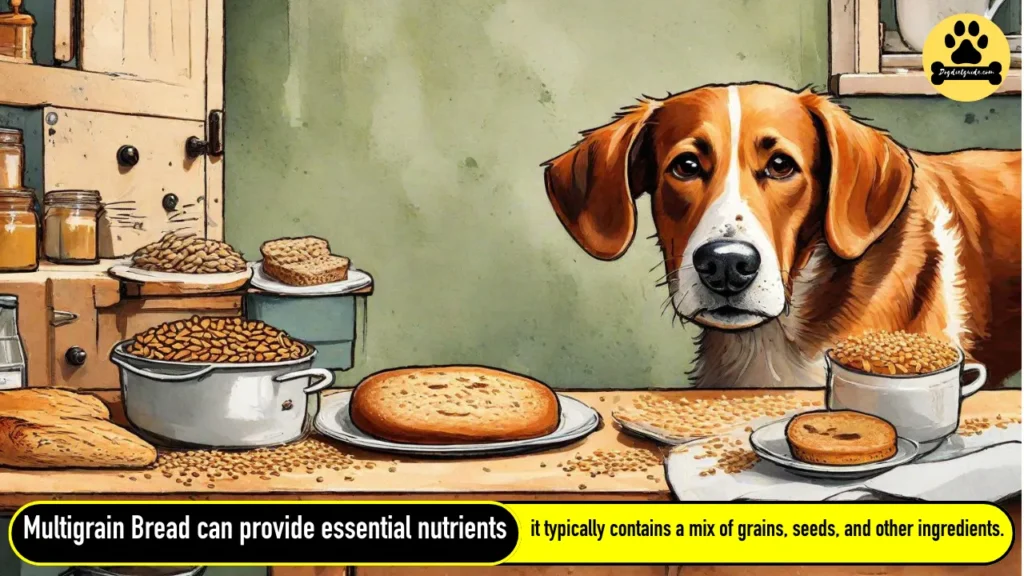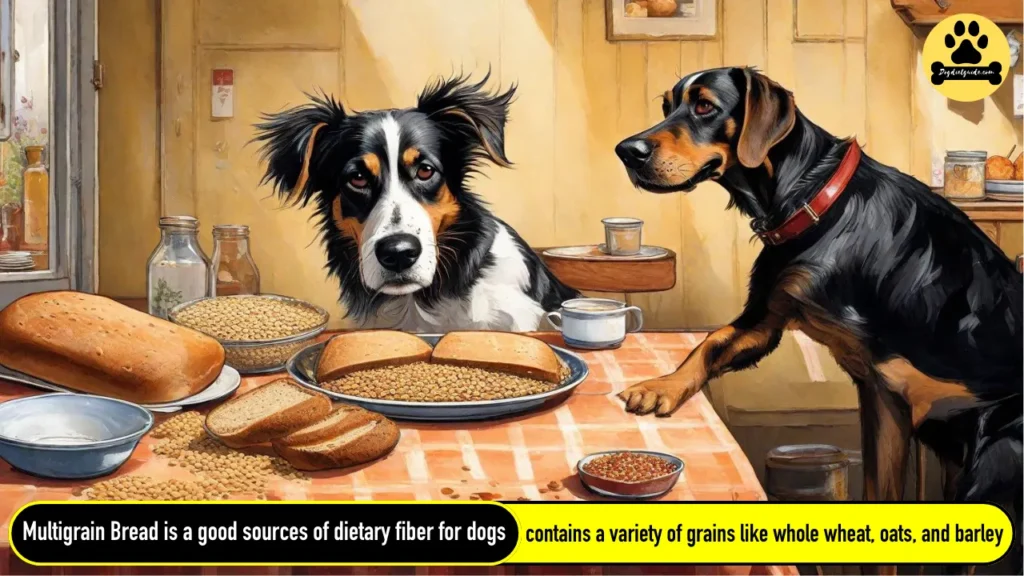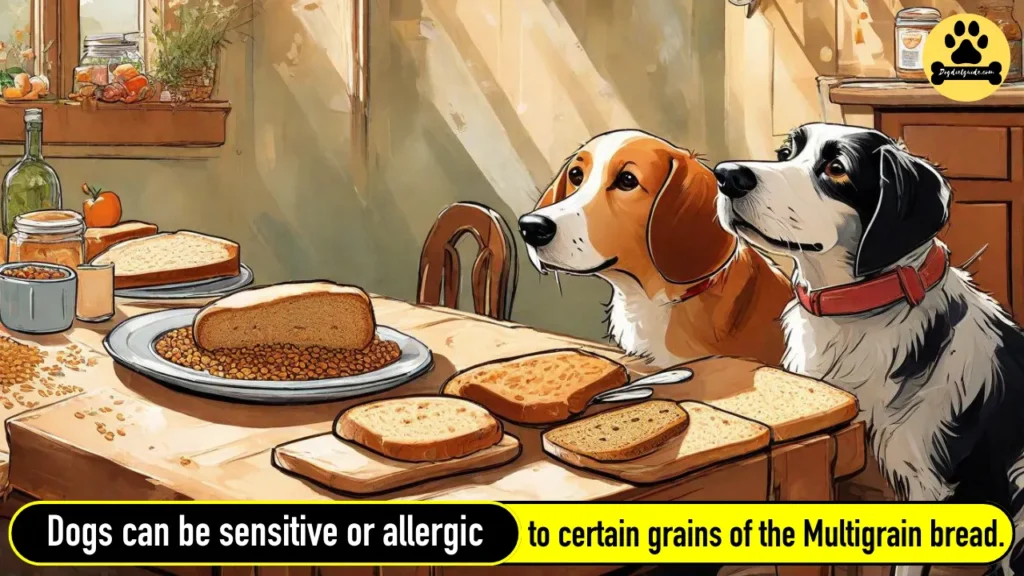In recent years, as pet owners strive to provide their furry companions with diverse and nutritious diets, questions about what foods are safe for dogs have become increasingly common. One such query is can dogs eat multigrain bread?
While many of us are accustomed to sharing our meals with our four-legged friends, navigating their dietary needs with caution is essential.
Can Dogs Eat Multigrain Bread?
Yes, dogs can eat multigrain bread in moderation, which can provide some essential nutrients. This grain-rich bread typically contains a mix of grains, seeds, and other ingredients. However, it must be acknowledged that dogs primarily require a protein-rich diet. Incorporating multigrain bread should be considered a supplementary treat rather than a staple.

Nutritional Components of Multigrain Bread
Multigrain bread for dog is a type of bread made from a variety of grains, each contributing different nutritional elements. The exact composition can vary, but common grains include wheat, oats, barley, and flaxseed.
Here are some critical dietary components found in multigrain key:
- Whole Grains:
- Provides dietary fiber for digestive health.
- It helps regulate blood sugar levels.
- Proteins:
- It contains protein, although lower than some other sources.
- Can be complemented with additional protein sources for a balanced diet.
- Vitamins and Minerals:
- Offers a variety of essential nutrients, including B vitamins, iron, magnesium, and zinc.
- Supports energy metabolism and immune system function.
- Healthy Fats:
- Some varieties include seeds or nuts, adding beneficial fats.
- Contributes to heart health, especially with omega-3 fatty acids from sources like flaxseed.
- Carbohydrates:
- A significant source of energy, providing carbohydrates.
- Whole grains offer complex carbohydrates for sustained energy.
Multigrain Bread Benefits For Dogs
- Multigrain bread often contains a variety of grains like whole wheat, oats, and barley, which are good sources of dietary fiber. Adequate fiber can promote digestive health in dogs by preventing constipation and regulating bowel movements.
- The carbohydrates in multigrain bread can quickly boost active dogs’ energy. This can be particularly beneficial for working dogs, those who exercise regularly, or those with high energy requirements.
- Different grains contribute various vitamins and minerals to the overall nutritional profile of multigrain bread. These nutrients, including skin, coat, and immune system health, can support your dog’s overall well-being.
- Some multigrain breads may include ingredients like flaxseeds, a source of omega-3 fatty acids. These essential fatty acids are beneficial for maintaining a healthy coat and skin.

Risks of Feeding Multigrain Bread to Dogs
- Dogs, like humans, can be sensitive or allergic to certain grains. Wheat, in particular, is a common allergen for dogs. If your dog shows signs of allergies, such as itching, gastrointestinal upset, or ear infections, it’s advisable to consult with a veterinarian.
- Commercial bread may contain additives, preservatives, or other ingredients unsuitable for dogs. Always check the ingredient list and avoid bread with potentially harmful components like raisins, nuts, or artificial sweeteners (xylitol), which can be toxic to canines.
- While bread can contribute to a pup’s caloric intake, it should not replace a balanced and nutritionally complete dog food. Excessive calorie consumption can lead to weight gain and associated health issues.

Related Post: Can Dogs Eat Buckwheat?
How To Safely Feed Multigrain Bread To Dogs?
If you decide to feed multigrain bread to your dog, it’s essential to do so safely and responsibly. Here are some guidelines to follow:
Before offering multigrain bread, ensure that your dog doesn’t have allergies or sensitivities to any ingredients or prevalent allergens like wheat. Monitor for any adverse reactions, such as itching, gastrointestinal upset, or changes in behavior.
Option for plain multigrain bread without added ingredients like raisins, nuts, seeds, or artificial sweeteners (xylitol). Some of these additives can be harmful or toxic to canines.
Treat multigrain bread as an occasional snack rather than a regular part of your dog’s diet. While it can offer some nutritional benefits, it should not replace their main meals or lead to excessive calorie intake.
Keep portions small, especially for smaller breeds. Too much bread can contribute to excessive calorie intake and potentially lead to weight gain.
If you share bread with your furry friend, consider removing the crust. The crust may be harder to digest and pose a choking hazard, especially for small puppies.
Do not add butter, spreads, or other condiments to the bread. These additions can introduce extra calories, fat, or ingredients that may not suit your dog.
After feeding your dog multigrain bread, monitor for digestive issues such as diarrhea or vomiting. If these symptoms occur, discontinuing feeding bread and consulting with a veterinarian may be best.

Before introducing any new food into your dog’s diet, consult your veterinarian, especially if your dog has pre-existing health conditions, allergies, or dietary restrictions.
Safe Alternatives
There are several safe alternatives to multigrain bread that you can consider when offering treats to your dog. Remember that new food should be introduced gradually to monitor your dog’s reaction.
- Plain Rice:
- Cooked plain rice is easily digestible and can be a gentle option for dogs with sensitive stomachs. It can also be mixed with simple lean proteins like boiled chicken or turkey.
- Plain Oatmeal:
- Plain-cooked oatmeal, without added sugar or flavorings, is a good source of fiber and can be a nutritious treat. It’s beneficial for dogs with digestive issues.
- Plain Popcorn:
- Air-popped popcorn without added salt, butter, or seasonings can be a light, low-calorie treat. Ensure that there are no unpopped kernels to prevent choking hazards.
- Plain Yogurt:
- Plain, unsweetened yogurt can be a good source of probiotics and calcium. It’s important to choose yogurt without added sugars or artificial sweeteners.
- Baby Carrots:
- Fresh baby carrots are low in calories and high in fiber. They also provide a crunchy texture that many dogs enjoy. Make sure the carrots are cut into small, manageable pieces.
- Apple Slices:
- Remove the seeds and core, then offer your dog small apple slices. Apples are a good source of vitamins and antioxidants, but moderation is vital due to the natural sugar content.
- Blueberries:
- Blueberries are a healthy and tasty option for dogs. They are rich in antioxidants and can serve as a low-calorie treat.
- Sweet Potato Chews:
- Baked or dehydrated sweet potato slices or cubes can be a delicious and nutritious alternative. Sweet potatoes are a good source of vitamins and fiber.
- Lean Meat Treats:
- Cooked, lean meats like chicken, turkey, or beef (without seasoning) can be cut into small pieces and used as training treats.
- Green Beans:
- Fresh or cooked green beans make for a low-calorie and crunchy treat. They are a good source of fiber and can be a healthy addition to your dog’s diet.
Related Post: Can Dogs Eat Buckwheat?
FAQs
Can dogs eat multigrain bread daily?
While small amounts occasionally may be safe, daily consumption is not recommended. Dogs thrive on a balanced diet, and relying on multigrain bread could lead to nutritional imbalances.
Are there specific grains dogs should avoid?
Yes, some grains like wheat and corn may cause dog allergies. You must monitor your pet for any signs of sensitivity and consult your vet if needed.
Can puppies eat multigrain bread?
Puppies have delicate digestive systems, and introducing complex foods like multigrain bread should be cautiously approached. Stick to their specialized puppy diet for optimal growth.
What are the signs of bread intolerance in dogs?
Watch for symptoms like vomiting, diarrhea, or lethargy. If your dog exhibits these signs after consuming multigrain bread, consult your veterinarian promptly.
Is whole-grain bread a safer option?
Yes, opting for plain whole-grain bread without additives is a safer choice. Still, moderation is vital to maintaining a balanced diet for your dog.
Can multigrain bread improve a dog’s coat?
While multigrain bread contains some nutrients beneficial for a dog’s coat, it should not be the primary source. Consult your vet for specialized dietary recommendations.
Final Thoughts: Can Dogs Eat Multigrain Bread?
In the quest to answer the burning question, “Can dogs eat multigrain bread?” it’s evident that moderation and awareness are key. Understanding your dog’s dietary needs and choosing treats wisely contribute to their well-being.
While multigrain bread can be a delightful occasional treat, responsible pet ownership involves making informed choices that prioritize your furry friend’s health.
” It is essential to emphasize that while we offer valuable insights, we do not intend to replace or undermine the importance of your veterinarian’s advice. The information presented on our site is purely for informational and educational purposes.”

I’m JK. A pet lover who has years of pet blogging experience. I thought it would be a great idea to share my experience with all dog owners so they can also keep their canine companions healthy and happy.






